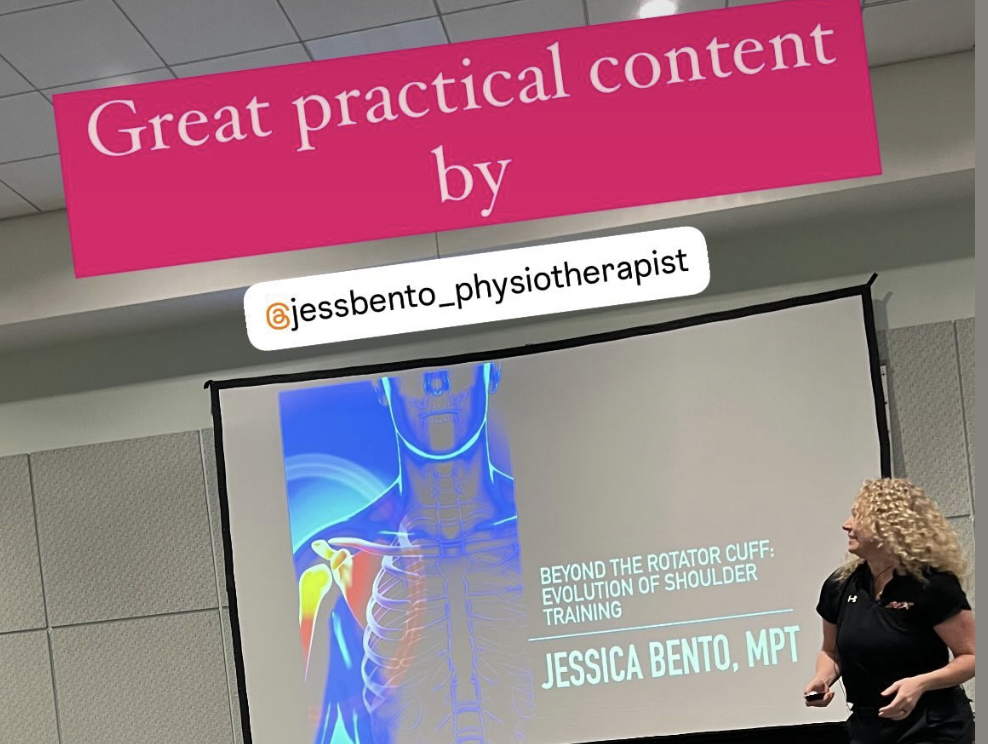Want To Improve Shoulder Pain Work On Hip Mobility
2024-08-19
Jessica Bento, Physical Therapist (Creator DVRT Restoration Certification, DVRT Rx Shoulder, Knees, Pelvic Control, & Gait Courses)

I’ve been fortunate enough to be presenting at the renowned Perform Better conferences for my 4th year. It is always so exciting to present information to fitness coaches, physical therapists, strength coaches, and chiropractors on methods that can be really impactful to their clients/patients’ lives. My topic this year was “Beyond The Rotator Cuff: The Evolution Of Shoulder Training”. I’m very happy that so many people have told me how eye opening it was, but I don’t want to keep it to those just attending these great conferences.
One of the big challenges for many people that have shoulder pain is that they become fearful of moving their shoulders. That is definitely something we do incrementally, but there is A LOT we can do to improve shoulder pain when people have a lot of hesitation. That really stems from focusing on core stability and hip mobility, sounds nuts right? However, the research says it isn’t as crazy as we may think. Here are a few examples….
“Recent literature has shown that efficiency and synchrony of the hips and core during an overhead movement (such as in baseball, golf, tennis, or volleyball) is essential for a powerful and precise execution of the task. Impairments of the hip and core, particularly abnormal joint mobility or weakness, can limit efficient energy transfer through the kinetic chain and may negatively impact performance…Abnormalities in hip range of motion, hip morphology, and core strength can lead to abnormal mechanics upstream in the kinetic chain, which may place athletes at risk of injuries.” (PMID: 38007174)

“Optimum shoulder and arm function in both normal athletic activity and rehabilitation is dependent on activation of the proximal segments of the kinetic chain—the legs, pelvis, and spine. If these segments are altered in posture, flexibility, or strength, they should be corrected in the early stages of rehabilitation. If and when they are normal, they should be used to initiate scapular and arm activation.” (PMID: 11888148)
“Glenohumeral Internal Rotation Deficit (GIRD), defined as a difference in internal rotation (IR) range of motion (ROM) between the two sides (Kibler, Sciascia, & Thomas, 2012), is a major risk factor for shoulder injuries in the general population and in overhead throwing athletes (Guney, Harput, Colakoglu, & Baltaci, 2016; Johnson, Fullmer, Nielsen, Johnson, & Moorman, 2018), including adolescent baseball (Lee, Kim, Song, Kim, & Woo, 2015; Norton et al., 2018) and young volleyball players (Saccol, Almedia, & de Souza, 2016). A multitude of local and global factors have been identified that could lead to GIRD…Global factors include improper sequence of muscle activation among lower extremity, trunk, and upper extremity joints (Laudner, Wong, Onuki, Lynall, & Meister, 2015); or impaired function of the respiratory diaphragm muscle, which has been shown to contribute to disturbed motion of the shoulder girdle (Hodges & Gandevia, 2000a,b; Kolar et al., 2009, 2010).” (PMID: 30326375)
View this post on Instagram
Strength Coach, Martin Adame shows a combination of DVRT drills that can help different levels of shoulder pain from those that have a hard time moving their shoulders and those that can move, but need that added hip mobility and core stability.
Our hip mobility and core stability efforts can also help our shoulder pain goals when we use breath work and mind-body practices. While they may seem simple, being aware how to “soften” your body and use the movement to unlock the ability not just of the shoulder, but the fascial connections that can impact our shoulder pain are essential.
“The pain intensity was significantly reduced, while flexion and abduction were significantly improved, in the experimental group compared to the control group, after the intervention. In addition, the change of flexion negatively correlated with the change of pain intensity in the experimental group, but not in the control group. These results show that a short-term application of mind-body intervention significantly alleviates shoulder pain and improves shoulder movement, suggesting its potential use as a therapy for people with shoulder pain.” (PMID: 35368768)
“Mind–body interventions embody an integrative therapeutic approach that recognizes the intricate connection between the mind and body in the context of health and wellness [18]. These practices are rooted in the concept that mental, emotional, and cognitive states can significantly influence physical health, and conversely, physical well-being can impact mental and emotional states [51]. Ranging from relaxation and breathing techniques to more structured forms of exercise such as yoga, Tai Chi, or meditation, these interventions aim not only to address physical symptoms but also to foster harmony and balance between the mental and physical aspects of the individual [52]. The results gleaned from the systematic review and meta-analysis furnish valuable insights into the efficacy of mind–body interventions in the treatment of chronic musculoskeletal pain.” (PMID: 38392633)
Check out how even if you have shoulder pain with movement of the shoulder we can still use strategies that Josh shows from our Myofascial Integrated Movement system to build qualities that reduce pain intensity and start to improve qualities of shoulder movement. Incorporating these concepts into your training can not only help shoulder pain issues, but can help make you more resilient over time to shoulder pain problems.
This week you can get a great opportunity to learn about meditative movement and other solutions for building healthy shoulders, knees, and even low backs. Save 25% all throughout DVRT and when you invest in any of our Ultimate Sandbag/Water Bags and get 2 of our top corrective exercise programs for FREE! Just use code “shoulder” HERE and you can check out our Myofascial Integrated Movement programs HERE 25% off.
© 2026 Ultimate Sandbag Training. Site by Jennifer Web Design.







